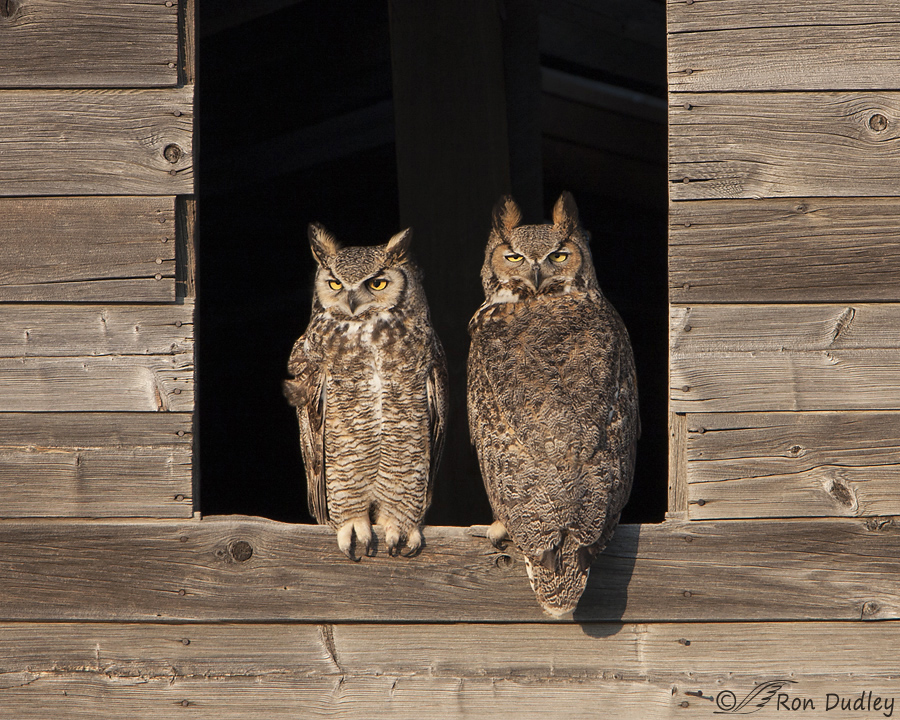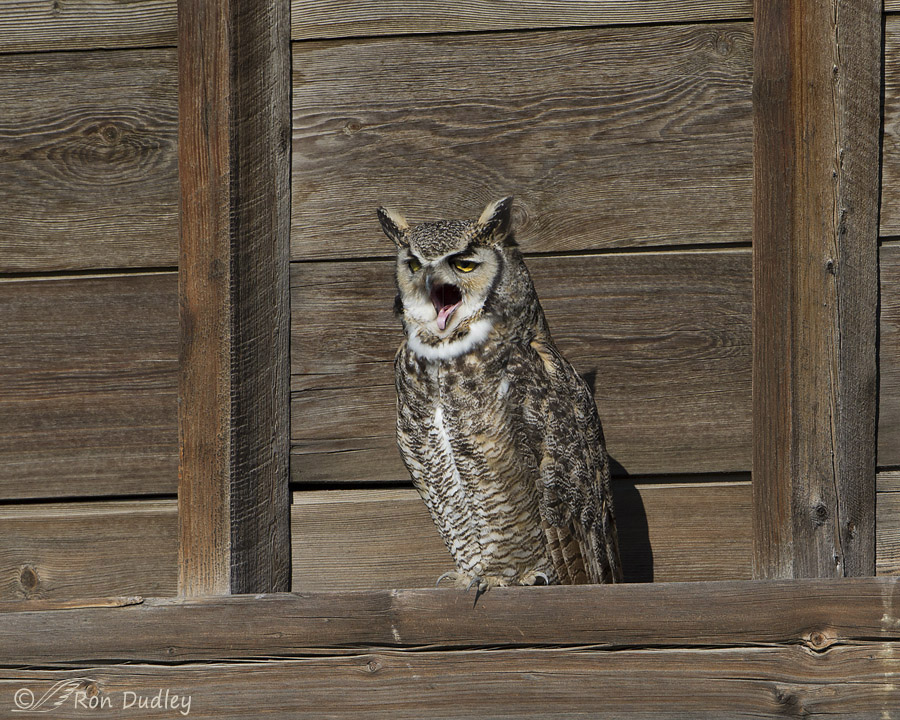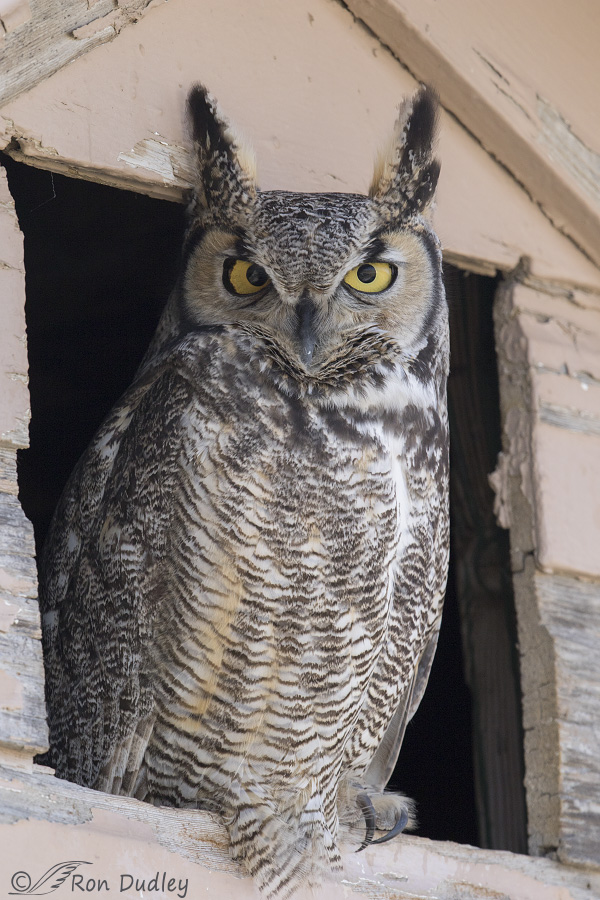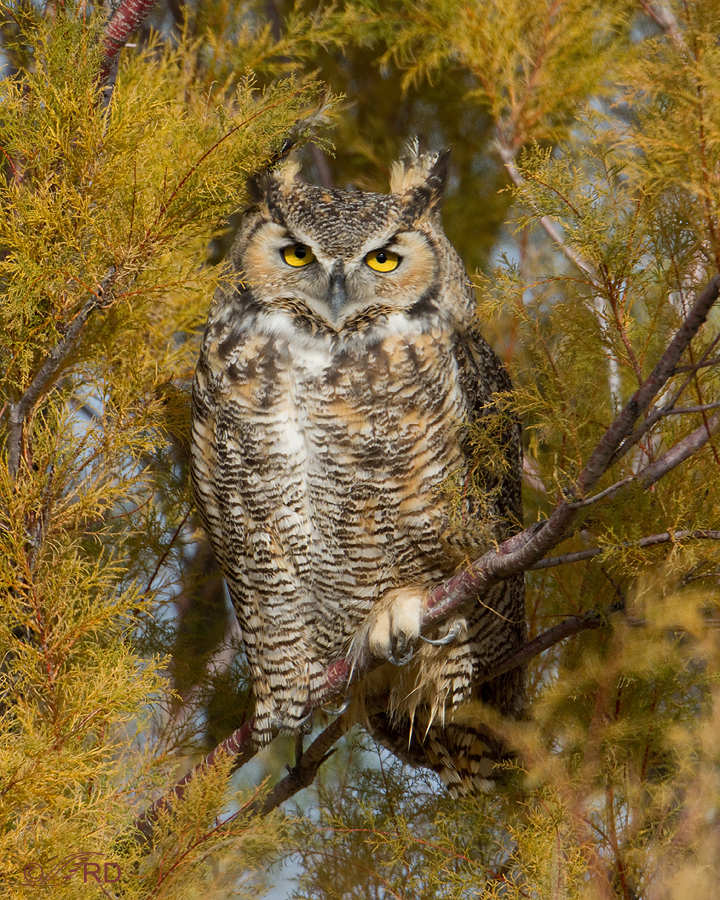Occasionally physical variations in birds cause me to do a double-take. That’s exactly what happened yesterday morning with a Great Horned Owl in Box Elder County and in this case it was because of the length of its ear tufts (“horns”).

1/400, f/8, ISO 400, Canon 40D, Canon EF 500mm f/4L IS USM + EF 1.4 Extender, not baited, set up or called in
I’ve photographed many Great Horned Owls over they years and virtually all of them, as adults, have ear tufts much like these. This is a mated pair that had been producing offspring on our Montana family farm for years. The larger female is on the right, the male on the left. Their ear tufts are about the length I expect to see in this species when erected. They’re also roughly the same length as the tufts of all the other adult GHOW’s I’ve seen and/or photographed, mostly in Utah and Montana.

1/2000, f/7.1, ISO 400, Canon 7D, Canon EF 500mm f/4L IS USM, extender, not baited, set up or called in
Here’s another Montana adult Great Horned Owl with its ear tufts erected (this bird is yawning).
Sorry, I couldn’t readily find the image techs on this image
And here’s one photographed in Utah.

1/500, f/7.1, ISO 500, Canon 7D Mark II, Canon EF 500mm f/4L IS II USM, not baited, set up or called in
But yesterday morning this bird (in truly dismal light) gave me a bit of a start. Its ear tufts seemed so long that in all honesty I wondered for a moment if the owl might be some sort of weird variation of a Long-eared Owl, even though it’s clearly a GHOW. I took tight shots of it (this one is full frame) partly because I was so enchanted by the length of those ear tufts.
I’m not claiming this bird is necessarily unique because I’ve seen a few photos of GHOW’s taken by others where the tufts are almost this long. But only “almost” and this bird was a first for me so it got me to thinking about why there can apparently be so much variation in adult GHOW ear tuft length.
Variation (in size, shape, color and everything else you can imagine) occurs in all genetically controlled traits, including ear tuft length – after all, variation is one of the primary fuels of evolution by natural selection. But most of those variations or differences are relatively small (though there is a bell curve involved) and we usually don’t even notice them. But this size difference seems pretty significant, at least to my untrained eye.
At first I wondered if it could be a regional difference. GHOW’s are non-migratory which might make regional differences more likely to develop but this bird was photographed here in Utah where I’ve photographed many others with more typically sized ear tufts. And I’ve never seen this exaggerated trait elsewhere where I photograph in the west either.
Do any of my readers in other parts of North America see GHOW’s with ear tufts this long? Or are they really not unusually long at all and it’s just something I’m imagining?
If so I’ll be embarrassed for bringing it up but in the end I had to ask anyway.
Ron
PS – Normally I would never approach an owl this closely (like I said, the image is full frame). But this bird was in the deep shade at the peak of the building and I didn’t even know it was there, only a few feet away, before I had stopped my pickup and turned off the engine for reasons unrelated to the bird.
Mia had to pee!



GADS but I love your blog. That’s all. With all the computer and life issues, I missed being here the most!
As for the ear tufts, those bell curves have extremes on both sides where few individuals go. Now go find one with short ear tufts! There’s your challenge for the day!
Fabulous shots, Ron! Let’s hear it for a well-timed micturition reflex!
Ha, you outdid me on that one, Marty!
I thought I recognized Mia’s owl but honestly did not notice its ears until you pointed them out.
She spotted it first so “Mia’s owl” it is…
Great Find, beautiful bird! My last pit stop at a pit toilet I found someones car keys. I wonder how they drove away?
Thanks, April. It begs the question, doesn’t it!
gorgeous photos!!
Thanks, Nicole.
HOW I wish my demanding bladder gave me rewards like that. On one emergency spot outside in the dark I squatted on a thistle. On another a cow pat was my reward.
What a beauty.
Big thanks to Mia and to you.
EC, before we were married my ex-wife did the same thing on a cactus. Her girlfriend spent over an hour picking tiny spines out of her butt the next day!
She was all my sympathies. Some of mine festered out. TMI I know.
As far as approaching too closely, I encountered a Great Horned Owl in my backyard perched on a short fence post that I didn’t notice until I was about 15 feet away. It seemed far less nonplussed than I. I have a sense that not much perturbs these birds (I even had my 50-pound dog with me on leash at the time). By the way, why do you abbreviate GHOW instead of GHO?
“why do you abbreviate GHOW instead of GHO?
Linda, Because that’s what it is in the American Ornithological Union Bird List.
Wonderful series of photos, Ron. I’ve learned that pit stops are a good excuse to look around and see what’s nearby…
Agreed, Dan. And peeing in the outdoors can be its own reward…
Wow those are crazy long. Loved seeing all the comparison shots too.
Thank you, Arwen.
Man, those are great shots of a Long-eared Great Horned Owl. Actually those are fantastic images of Great Horns, I am extremely envious. They look very relaxed, you must have been in your truck?
Hope your weather is getting better. Ours is going down hill!
Thanks, Dick. I was in my pickup for the last two shots but not for the first two. I’m usually shooting those farm owls on foot using a tripod.
We have crappola for weather. Socked in with so much fog and pollution from the inversion that you can barely see across the street. 18° F. as I type.
Bird’s right eye looks wonky….is it???
I wondered the same thing but I doubt it.
I’ve never seen ear tufts that long here in Alabama. My only real experience with GHOs was returning a juvenile to his nest area after he was found out of the nest and I transported him to the Wildlife Center in Birmingham to be examined. They sent him (and a few frozen mice) back with me and the next evening I put him up in a tree near his nest tree, as it was not accessible by just me and a ladder. The majority of the owls I transport are barred owls, with an occasional screech owl and GHO. They are very beautiful ear tufts!!
“I’ve never seen ear tufts that long here in Alabama”
Interesting, Leisa. Thanks.
Improbable as it may seem, that GHO is obviously the result of crossung a GHO with either a jackrabbit or a muley….I think they are quite rare….
Related to the rare and elusive jackalope perhaps…
I wonderd about that….
Those are very interesting ear tufts. I’ve only encountered one GHOW on one occasion, and that one had “normal” length ear tufts. The one I got to see was at some distance, and blended in so well with the rocks it was on that it was hard to see. I have also gotten to see Long-eared Owls, and their ear tufts were far more similar to this GHOW. Fortunately their colorations are so different it’s not hard to tell the difference between them. (I can’t believe I have actually had a chance to see both species in person.)
Yes, colors and patterns are quite different in the two species, Susan. Even so, I’ll admit that “Long-eared Owl” was the first thing that came to mind when I first saw this bird in good detail through my lens. Those “ears” just really stood out for me.
They seem long to me too. However, a Google image search reveals some similarly long. So I think this is just one of those individuals that is about two standard deviations toward the long side of the bell curve.
I think it probably is too, David. Interesting that this particular trait shows so much apparent variation while many others do not…
Those ARE exceptionally long. We had one around quite a few years ago with very long tufts that I initially thought was a long-eared owl, BUT the rest matched the GHOW’s we have around and I didn’t figure the GHOW’s would tolerate it were it a long-eared owl. Just shrugged it off as a bit of a puzzle………….
Thanks, Judy. I found your comment especially interesting because your report was from Montana, as many of my GHOW’s have been.
Glad Mia had to make a pit stop! All the photo’s are great – particularly like the one yawning………..:)
All the photo’s are great – particularly like the one yawning………..:)
Yup, we owe this bird to Mia’s functional nephrons…